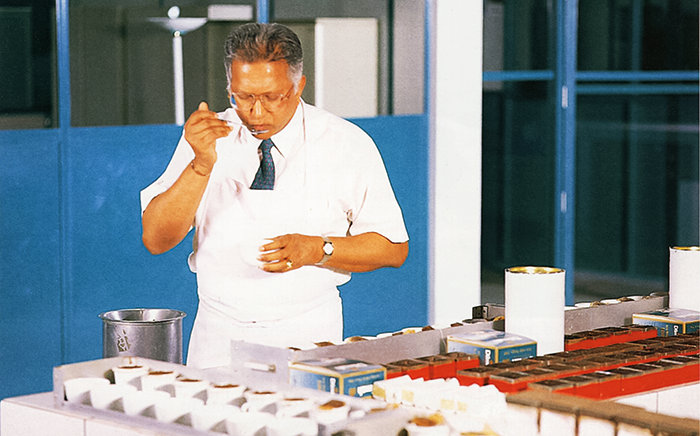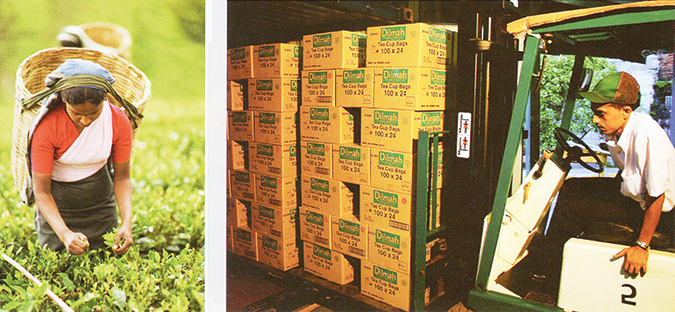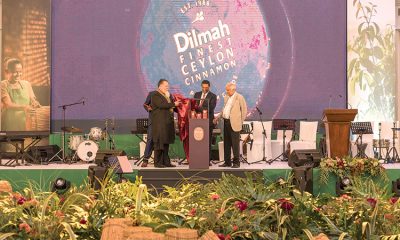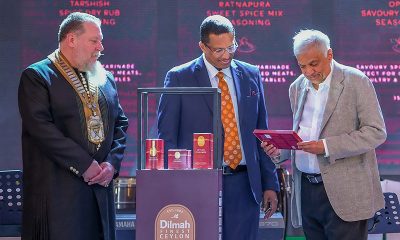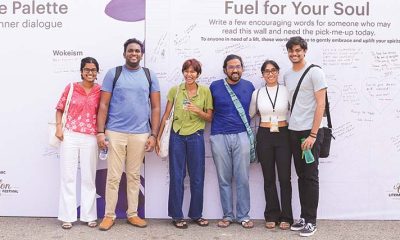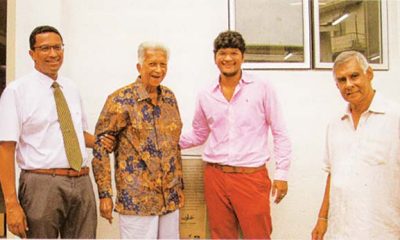Features
Dilmah, my personal ethos and my commitment to marketing a single origin Ceylon tea
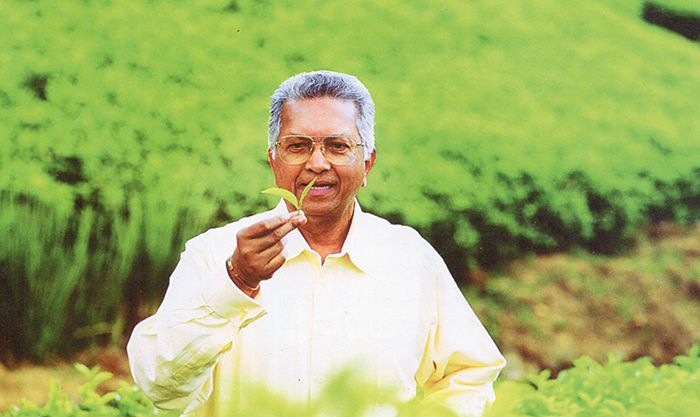
(Excerpted from the Merrill J. Fernando autobiography)
Decades ago, before supermarket chains marketing international brands overwhelmed the consumers’ perception of quality, with marketing hyperbole surrounding mediocre products, it was the neighbourhood grocer running his own shop, who personally wrapped your goods and handed them over the counter. There was meaningful conversation between the two and the transaction implied immediate accountability of the supplier to the consumer.
Today that relationship has been replaced by the faceless and voiceless supermarket retailer, who supports a convenience lifestyle, but leaves no space for direct accountability for product quality.
Most of the currently popular global brands were first launched and developed by small, single entrepreneurs, with a passion for delivering a product with genuine value to the customer. Many of them led small- or medium-sized family companies, such as mine, which competed with each other on product quality, and not by price discounting. These were companies which had been in business for generations and, over time, nurtured their brands with great care and passion.
In time, many such brands, seduced by attractive take-over offers, sold out to massive corporate interests, which marketed the brands on their old, established value propositions, but debased the product in order to lower costs. That is the point at which a product with an intrinsic composite value of individuality and authenticity, becomes a boring, anonymous commodity, to be traded at the mass market label owners’ will.
The small- and medium-scale suppliers who concentrate on quality and the delivery of an authentic product to the consumer, at a commensurate price, were eventually forced out of business, in their inability to accept deep cost reductions whilst still maintaining product integrity. The concentration of the tea industry in the hands of multinationals, Global outreach, changed the priorities of the brands that they acquired from smaller companies.
The passion of the brand founder for authenticity and quality was replaced by the greed for profit, which often meant the debasement of quality. These altered priorities inevitably drove the new brand owners to progressively cheaper sources for tea, in the process sacrificing quality and stifling innovation. Consequently, what is ultimately delivered to the consumer is a commercially viable, low-quality product.
That is exactly what has happened to Ceylon Tea, in many parts of the world where it is still consumed; in the hands of the large multinational retailers, it has become commoditised. The ‘Pure Ceylon Tea’ label was first diminished to ‘Ceylon Blend,’ degraded further to `Ceylon Type,’ and eventually disappeared altogether. However, the customer, anesthetized to reality by the original value perception, and his judgment clouded by marketing make-believe and the hard-sell of attractively-wrapped fiction, continued to patronize the devalued product. Brand loyalty is one-sided. The multinational brand owner has no allegiance to the consumer or the product, but only to profit.
The massive consumption this system generated was followed by fierce competition for shelf space between different brands, leading to progressive lowering of quality by the packer, in order to manage production costs and to remain profitable. The power of multinational traders enabled them to dictate and manipulate the product price, whether it be tea or coffee. The core philosophy of big business is not to be better, but bigger and more profitable. It is an ugly culture in which there is no place for ethics, or the delivery of genuine value. It is an ethos which is certain to generate a race to the bottom, in which the winner is, inevitably, the least scrupulous.
One factor which worked in my favour then, and continues to do so today, was that when I launched Dilmah, it would have been the first time that a brand founder cum brand owner was making personal visits to the countries of consumption to promote his product. With my style of direct, personal marketing, I reintroduced the concept of the producer’s personal accountability to the consumer. I spoke to the consumer and also listened to him. If the product is genuine, the consumer will ensure the success of the brand.
Perhaps fortunately, I had neither studied marketing as a subject, nor ever read a book on marketing. Therefore, I relied on my instinct and the intimate personal knowledge of overseas tea marketing that I had gathered in over four decades up to that time. Those two factors have rarely failed me and they did not fail me in Australia. I knew enough about my product to answer any question on it, unlike a marketing or sales representative, who may not have had comprehensive knowledge of the product or, most importantly, a genuine passion for what he was selling.
Unlike a paid salesman, I was able to tell the potential buyer confidently, that my product was the best and explain why it was so. I talked and lived tea and was not simply selling it. Equally important, there was my unshakable belief that God helps those who strive with diligence and integrity.
As a small, single entrepreneur from a small country, both with limited resources, fighting against multinationals with seemingly-limitless advertising budgets and deep outreach across continents, I gradually came to realize that I had a matchless advantage when it came to product promotion. The multinational was a huge, faceless entity, with no morality and no allegiance to anybody or anything,
except to profit. There was no accountability between the supplier, seller, product, and consumer. It represented a callous, commercial chain with dis-empowered links.
Dilmah, on the other hand, had an intimate brand image, a face, a real man to that face and, behind that man, a real family. The consumer was able to relate his morning cup of tea to a flesh and blood person. It was a unique concept of integrated connectivity, from beginning to end. Dilmah was the only tea brand which provided genuine ‘Garden to Cup’ answerability. In its totality, it spoke of association, authenticity, and accountability, which are perceptions of unquantifiable worth in any relationship, whether it be personal or commercial.
My Dilmah was a dream, dreamt by me as a young man in his early twenties, at the very beginning of his career, serving a colonial master in a field hitherto inaccessible to Ceylonese. It took almost four decades for that dream to reach reality and fruition. That long journey was signposted by hope and despair, success and failure, and active assistance and deliberate sabotage. Finally, my perseverance prevailed, supported by an enduring faith in the inherent goodness of Pure Ceylon Tea, in my ability as a tea-maker, and in my God.
As a consequence of my direct approach and acceptance of personal responsibility for my brand, the buyers became my close friends and took me into their hearts and their homes. I got to know their families and they got to know mine. They understood that my concern for the quality of the product and its acceptance by the consumer genuinely superseded the profit motive.
My Unique Selling Point was that what I presented was garden fresh, unblended, Pure Ceylon Tea and of a genuinely single, and singular, origin. It was packed where it was grown. I was not just a seller or a marketer, or a middleman, selling a product he had no link to, but the head of a close-knit family, which was selling its own creation. I was also a messenger on behalf of a peerless product.
Marketing strategies and styles need to evolve constantly, in order to keep abreast of changing consumer patterns and competition from other products, the latter exerting relentless pressure on the seller of any brand or product. Similarly, with the introduction of electronic mass media and social media platforms delivering instant knowledge globally, my company has also been compelled to frequently adjust its marketing strategies, in order to respond effectively to such daunting challenges.
However, irrespective of the intensity of the contest and the rewards at stake, Dilmah has not, and will not, compromise on its founding principle of quality and purity. As I have said repeatedly in this writing, that core concept is immutable. I cannot say it often enough. Tradition is our bedrock and sustainability, with authenticity our goal. I do not believe in quick fixes to any problem, whether in life or in the marketing of tea.
At the time I launched Dilmah, ‘Ethical Trade’ and ‘Fair Trade’ were not the common currency of the marketing of tea, as they are today. The strength of Dilmah was its commitment to quality and authenticity, which is declared in every pack, supported by the family philosophy behind the brand. In a world of large traders, Dilmah was a farmers’ tea brand, overriding the middleman and going directly to supermarkets the world over.
We did not try to replicate the successful strategies of our larger competitors. We developed our own business concepts, designs, and packaging, whilst our marketing platform clearly reflected our family values and aspirations. Those were our unique selling points, and, in the end, they made the difference.
Dilmah is possibly the one internationally-marketed tea brand which buys its product only from the country where it is grown, and that which is owned, packed, and marketed by the same country, all within one family, with the revenue flowing back to the country of origin. The surplus from that trade also stays in the country of origin. It is that surplus which enables the Dilmah contribution to social justice, environmental conservation, and other worthy causes that benefit the community.
In my mind that is an enterprise model without peer. Well before the ‘Ethical Trade’ and ‘Fair Trade’ labels entered the formal marketing lexicon of the local and international tea trade, as either desirable attributes or mandatory requirements, Dilmah was already voluntarily compliant.
If there is a lesson in Dilmah, it is a very simple one. I followed a dream relentlessly, with passion and integrity, and shared it with my consumers. They listened to me because I was an ordinary man whom they could identify with, telling a story with a simple message that they could understand and believe in. My story never changed because it was a simple truth. I was successful in the delivery of that
message because I had total confidence in myself, a comprehensive knowledge of my product, and complete faith in divine guidance. The timely and happy confluence of those unvarnished verities invested the Dilmah story with the enduring resonance of sustainability and credibility, which are its greatest strengths.
Features
The heart-friendly health minister

by Dr Gotabhya Ranasinghe
Senior Consultant Cardiologist
National Hospital Sri Lanka
When we sought a meeting with Hon Dr. Ramesh Pathirana, Minister of Health, he graciously cleared his busy schedule to accommodate us. Renowned for his attentive listening and deep understanding, Minister Pathirana is dedicated to advancing the health sector. His openness and transparency exemplify the qualities of an exemplary politician and minister.
Dr. Palitha Mahipala, the current Health Secretary, demonstrates both commendable enthusiasm and unwavering support. This combination of attributes makes him a highly compatible colleague for the esteemed Minister of Health.
Our discussion centered on a project that has been in the works for the past 30 years, one that no other minister had managed to advance.
Minister Pathirana, however, recognized the project’s significance and its potential to revolutionize care for heart patients.
The project involves the construction of a state-of-the-art facility at the premises of the National Hospital Colombo. The project’s location within the premises of the National Hospital underscores its importance and relevance to the healthcare infrastructure of the nation.
This facility will include a cardiology building and a tertiary care center, equipped with the latest technology to handle and treat all types of heart-related conditions and surgeries.
Securing funding was a major milestone for this initiative. Minister Pathirana successfully obtained approval for a $40 billion loan from the Asian Development Bank. With the funding in place, the foundation stone is scheduled to be laid in September this year, and construction will begin in January 2025.
This project guarantees a consistent and uninterrupted supply of stents and related medications for heart patients. As a result, patients will have timely access to essential medical supplies during their treatment and recovery. By securing these critical resources, the project aims to enhance patient outcomes, minimize treatment delays, and maintain the highest standards of cardiac care.
Upon its fruition, this monumental building will serve as a beacon of hope and healing, symbolizing the unwavering dedication to improving patient outcomes and fostering a healthier society.We anticipate a future marked by significant progress and positive outcomes in Sri Lanka’s cardiovascular treatment landscape within the foreseeable timeframe.
Features
A LOVING TRIBUTE TO JESUIT FR. ALOYSIUS PIERIS ON HIS 90th BIRTHDAY

by Fr. Emmanuel Fernando, OMI
Jesuit Fr. Aloysius Pieris (affectionately called Fr. Aloy) celebrated his 90th birthday on April 9, 2024 and I, as the editor of our Oblate Journal, THE MISSIONARY OBLATE had gone to press by that time. Immediately I decided to publish an article, appreciating the untiring selfless services he continues to offer for inter-Faith dialogue, the renewal of the Catholic Church, his concern for the poor and the suffering Sri Lankan masses and to me, the present writer.
It was in 1988, when I was appointed Director of the Oblate Scholastics at Ampitiya by the then Oblate Provincial Fr. Anselm Silva, that I came to know Fr. Aloy more closely. Knowing well his expertise in matters spiritual, theological, Indological and pastoral, and with the collaborative spirit of my companion-formators, our Oblate Scholastics were sent to Tulana, the Research and Encounter Centre, Kelaniya, of which he is the Founder-Director, for ‘exposure-programmes’ on matters spiritual, biblical, theological and pastoral. Some of these dimensions according to my view and that of my companion-formators, were not available at the National Seminary, Ampitiya.
Ever since that time, our Oblate formators/ accompaniers at the Oblate Scholasticate, Ampitiya , have continued to send our Oblate Scholastics to Tulana Centre for deepening their insights and convictions regarding matters needed to serve the people in today’s context. Fr. Aloy also had tried very enthusiastically with the Oblate team headed by Frs. Oswald Firth and Clement Waidyasekara to begin a Theologate, directed by the Religious Congregations in Sri Lanka, for the contextual formation/ accompaniment of their members. It should very well be a desired goal of the Leaders / Provincials of the Religious Congregations.
Besides being a formator/accompanier at the Oblate Scholasticate, I was entrusted also with the task of editing and publishing our Oblate journal, ‘The Missionary Oblate’. To maintain the quality of the journal I continue to depend on Fr. Aloy for his thought-provoking and stimulating articles on Biblical Spirituality, Biblical Theology and Ecclesiology. I am very grateful to him for his generous assistance. Of late, his writings on renewal of the Church, initiated by Pope St. John XX111 and continued by Pope Francis through the Synodal path, published in our Oblate journal, enable our readers to focus their attention also on the needed renewal in the Catholic Church in Sri Lanka. Fr. Aloy appreciated very much the Synodal path adopted by the Jesuit Pope Francis for the renewal of the Church, rooted very much on prayerful discernment. In my Religious and presbyteral life, Fr.Aloy continues to be my spiritual animator / guide and ongoing formator / acccompanier.
Fr. Aloysius Pieris, BA Hons (Lond), LPh (SHC, India), STL (PFT, Naples), PhD (SLU/VC), ThD (Tilburg), D.Ltt (KU), has been one of the eminent Asian theologians well recognized internationally and one who has lectured and held visiting chairs in many universities both in the West and in the East. Many members of Religious Congregations from Asian countries have benefited from his lectures and guidance in the East Asian Pastoral Institute (EAPI) in Manila, Philippines. He had been a Theologian consulted by the Federation of Asian Bishops’ Conferences for many years. During his professorship at the Gregorian University in Rome, he was called to be a member of a special group of advisers on other religions consulted by Pope Paul VI.
Fr. Aloy is the author of more than 30 books and well over 500 Research Papers. Some of his books and articles have been translated and published in several countries. Among those books, one can find the following: 1) The Genesis of an Asian Theology of Liberation (An Autobiographical Excursus on the Art of Theologising in Asia, 2) An Asian Theology of Liberation, 3) Providential Timeliness of Vatican 11 (a long-overdue halt to a scandalous millennium, 4) Give Vatican 11 a chance, 5) Leadership in the Church, 6) Relishing our faith in working for justice (Themes for study and discussion), 7) A Message meant mainly, not exclusively for Jesuits (Background information necessary for helping Francis renew the Church), 8) Lent in Lanka (Reflections and Resolutions, 9) Love meets wisdom (A Christian Experience of Buddhism, 10) Fire and Water 11) God’s Reign for God’s poor, 12) Our Unhiddden Agenda (How we Jesuits work, pray and form our men). He is also the Editor of two journals, Vagdevi, Journal of Religious Reflection and Dialogue, New Series.
Fr. Aloy has a BA in Pali and Sanskrit from the University of London and a Ph.D in Buddhist Philosophy from the University of Sri Lankan, Vidyodaya Campus. On Nov. 23, 2019, he was awarded the prestigious honorary Doctorate of Literature (D.Litt) by the Chancellor of the University of Kelaniya, the Most Venerable Welamitiyawe Dharmakirthi Sri Kusala Dhamma Thera.
Fr. Aloy continues to be a promoter of Gospel values and virtues. Justice as a constitutive dimension of love and social concern for the downtrodden masses are very much noted in his life and work. He had very much appreciated the commitment of the late Fr. Joseph (Joe) Fernando, the National Director of the Social and Economic Centre (SEDEC) for the poor.
In Sri Lanka, a few religious Congregations – the Good Shepherd Sisters, the Christian Brothers, the Marist Brothers and the Oblates – have invited him to animate their members especially during their Provincial Congresses, Chapters and International Conferences. The mainline Christian Churches also have sought his advice and followed his seminars. I, for one, regret very much, that the Sri Lankan authorities of the Catholic Church –today’s Hierarchy—- have not sought Fr.
Aloy’s expertise for the renewal of the Catholic Church in Sri Lanka and thus have not benefited from the immense store of wisdom and insight that he can offer to our local Church while the Sri Lankan bishops who governed the Catholic church in the immediate aftermath of the Second Vatican Council (Edmund Fernando OMI, Anthony de Saram, Leo Nanayakkara OSB, Frank Marcus Fernando, Paul Perera,) visited him and consulted him on many matters. Among the Tamil Bishops, Bishop Rayappu Joseph was keeping close contact with him and Bishop J. Deogupillai hosted him and his team visiting him after the horrible Black July massacre of Tamils.
Features
A fairy tale, success or debacle

Sri Lanka-Singapore Free Trade Agreement
By Gomi Senadhira
senadhiragomi@gmail.com
“You might tell fairy tales, but the progress of a country cannot be achieved through such narratives. A country cannot be developed by making false promises. The country moved backward because of the electoral promises made by political parties throughout time. We have witnessed that the ultimate result of this is the country becoming bankrupt. Unfortunately, many segments of the population have not come to realize this yet.” – President Ranil Wickremesinghe, 2024 Budget speech
Any Sri Lankan would agree with the above words of President Wickremesinghe on the false promises our politicians and officials make and the fairy tales they narrate which bankrupted this country. So, to understand this, let’s look at one such fairy tale with lots of false promises; Ranil Wickremesinghe’s greatest achievement in the area of international trade and investment promotion during the Yahapalana period, Sri Lanka-Singapore Free Trade Agreement (SLSFTA).
It is appropriate and timely to do it now as Finance Minister Wickremesinghe has just presented to parliament a bill on the National Policy on Economic Transformation which includes the establishment of an Office for International Trade and the Sri Lanka Institute of Economics and International Trade.
Was SLSFTA a “Cleverly negotiated Free Trade Agreement” as stated by the (former) Minister of Development Strategies and International Trade Malik Samarawickrama during the Parliamentary Debate on the SLSFTA in July 2018, or a colossal blunder covered up with lies, false promises, and fairy tales? After SLSFTA was signed there were a number of fairy tales published on this agreement by the Ministry of Development Strategies and International, Institute of Policy Studies, and others.
However, for this article, I would like to limit my comments to the speech by Minister Samarawickrama during the Parliamentary Debate, and the two most important areas in the agreement which were covered up with lies, fairy tales, and false promises, namely: revenue loss for Sri Lanka and Investment from Singapore. On the other important area, “Waste products dumping” I do not want to comment here as I have written extensively on the issue.
1. The revenue loss
During the Parliamentary Debate in July 2018, Minister Samarawickrama stated “…. let me reiterate that this FTA with Singapore has been very cleverly negotiated by us…. The liberalisation programme under this FTA has been carefully designed to have the least impact on domestic industry and revenue collection. We have included all revenue sensitive items in the negative list of items which will not be subject to removal of tariff. Therefore, 97.8% revenue from Customs duty is protected. Our tariff liberalisation will take place over a period of 12-15 years! In fact, the revenue earned through tariffs on goods imported from Singapore last year was Rs. 35 billion.
The revenue loss for over the next 15 years due to the FTA is only Rs. 733 million– which when annualised, on average, is just Rs. 51 million. That is just 0.14% per year! So anyone who claims the Singapore FTA causes revenue loss to the Government cannot do basic arithmetic! Mr. Speaker, in conclusion, I call on my fellow members of this House – don’t mislead the public with baseless criticism that is not grounded in facts. Don’t look at petty politics and use these issues for your own political survival.”
I was surprised to read the minister’s speech because an article published in January 2018 in “The Straits Times“, based on information released by the Singaporean Negotiators stated, “…. With the FTA, tariff savings for Singapore exports are estimated to hit $10 million annually“.
As the annual tariff savings (that is the revenue loss for Sri Lanka) calculated by the Singaporean Negotiators, Singaporean $ 10 million (Sri Lankan rupees 1,200 million in 2018) was way above the rupees’ 733 million revenue loss for 15 years estimated by the Sri Lankan negotiators, it was clear to any observer that one of the parties to the agreement had not done the basic arithmetic!
Six years later, according to a report published by “The Morning” newspaper, speaking at the Committee on Public Finance (COPF) on 7th May 2024, Mr Samarawickrama’s chief trade negotiator K.J. Weerasinghehad had admitted “…. that forecasted revenue loss for the Government of Sri Lanka through the Singapore FTA is Rs. 450 million in 2023 and Rs. 1.3 billion in 2024.”
If these numbers are correct, as tariff liberalisation under the SLSFTA has just started, we will pass Rs 2 billion very soon. Then, the question is how Sri Lanka’s trade negotiators made such a colossal blunder. Didn’t they do their basic arithmetic? If they didn’t know how to do basic arithmetic they should have at least done their basic readings. For example, the headline of the article published in The Straits Times in January 2018 was “Singapore, Sri Lanka sign FTA, annual savings of $10m expected”.
Anyway, as Sri Lanka’s chief negotiator reiterated at the COPF meeting that “…. since 99% of the tariffs in Singapore have zero rates of duty, Sri Lanka has agreed on 80% tariff liberalisation over a period of 15 years while expecting Singapore investments to address the imbalance in trade,” let’s turn towards investment.
Investment from Singapore
In July 2018, speaking during the Parliamentary Debate on the FTA this is what Minister Malik Samarawickrama stated on investment from Singapore, “Already, thanks to this FTA, in just the past two-and-a-half months since the agreement came into effect we have received a proposal from Singapore for investment amounting to $ 14.8 billion in an oil refinery for export of petroleum products. In addition, we have proposals for a steel manufacturing plant for exports ($ 1 billion investment), flour milling plant ($ 50 million), sugar refinery ($ 200 million). This adds up to more than $ 16.05 billion in the pipeline on these projects alone.
And all of these projects will create thousands of more jobs for our people. In principle approval has already been granted by the BOI and the investors are awaiting the release of land the environmental approvals to commence the project.
I request the Opposition and those with vested interests to change their narrow-minded thinking and join us to develop our country. We must always look at what is best for the whole community, not just the few who may oppose. We owe it to our people to courageously take decisions that will change their lives for the better.”
According to the media report I quoted earlier, speaking at the Committee on Public Finance (COPF) Chief Negotiator Weerasinghe has admitted that Sri Lanka was not happy with overall Singapore investments that have come in the past few years in return for the trade liberalisation under the Singapore-Sri Lanka Free Trade Agreement. He has added that between 2021 and 2023 the total investment from Singapore had been around $162 million!
What happened to those projects worth $16 billion negotiated, thanks to the SLSFTA, in just the two-and-a-half months after the agreement came into effect and approved by the BOI? I do not know about the steel manufacturing plant for exports ($ 1 billion investment), flour milling plant ($ 50 million) and sugar refinery ($ 200 million).
However, story of the multibillion-dollar investment in the Petroleum Refinery unfolded in a manner that would qualify it as the best fairy tale with false promises presented by our politicians and the officials, prior to 2019 elections.
Though many Sri Lankans got to know, through the media which repeatedly highlighted a plethora of issues surrounding the project and the questionable credentials of the Singaporean investor, the construction work on the Mirrijiwela Oil Refinery along with the cement factory began on the24th of March 2019 with a bang and Minister Ranil Wickremesinghe and his ministers along with the foreign and local dignitaries laid the foundation stones.
That was few months before the 2019 Presidential elections. Inaugurating the construction work Prime Minister Ranil Wickremesinghe said the projects will create thousands of job opportunities in the area and surrounding districts.
The oil refinery, which was to be built over 200 acres of land, with the capacity to refine 200,000 barrels of crude oil per day, was to generate US$7 billion of exports and create 1,500 direct and 3,000 indirect jobs. The construction of the refinery was to be completed in 44 months. Four years later, in August 2023 the Cabinet of Ministers approved the proposal presented by President Ranil Wickremesinghe to cancel the agreement with the investors of the refinery as the project has not been implemented! Can they explain to the country how much money was wasted to produce that fairy tale?
It is obvious that the President, ministers, and officials had made huge blunders and had deliberately misled the public and the parliament on the revenue loss and potential investment from SLSFTA with fairy tales and false promises.
As the president himself said, a country cannot be developed by making false promises or with fairy tales and these false promises and fairy tales had bankrupted the country. “Unfortunately, many segments of the population have not come to realize this yet”.
(The writer, a specialist and an activist on trade and development issues . )

